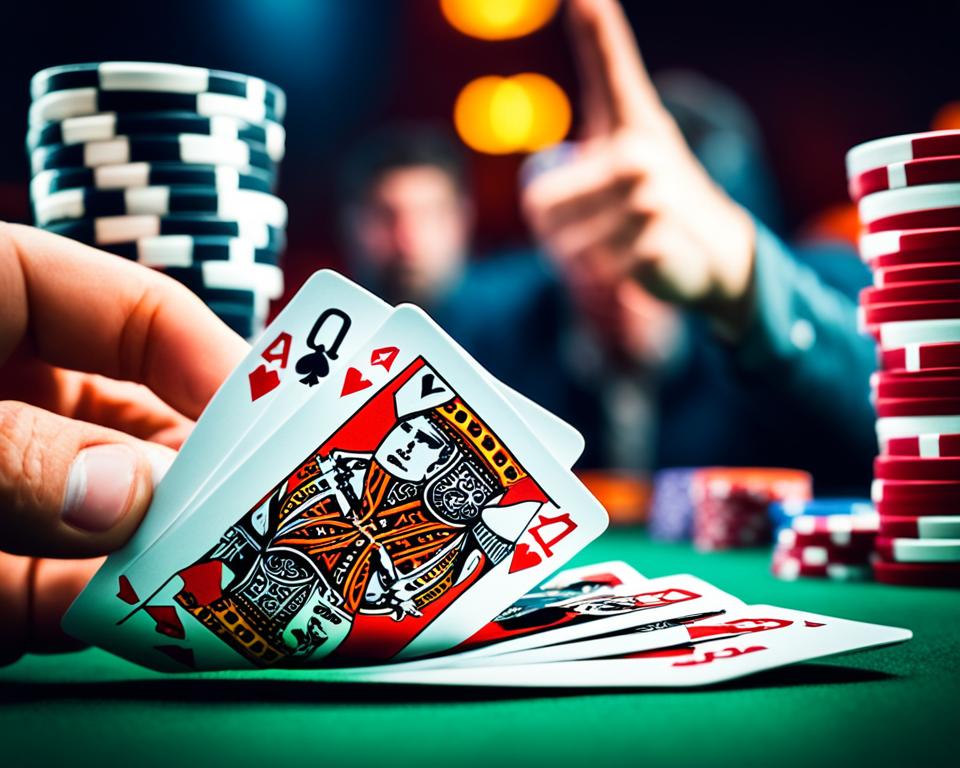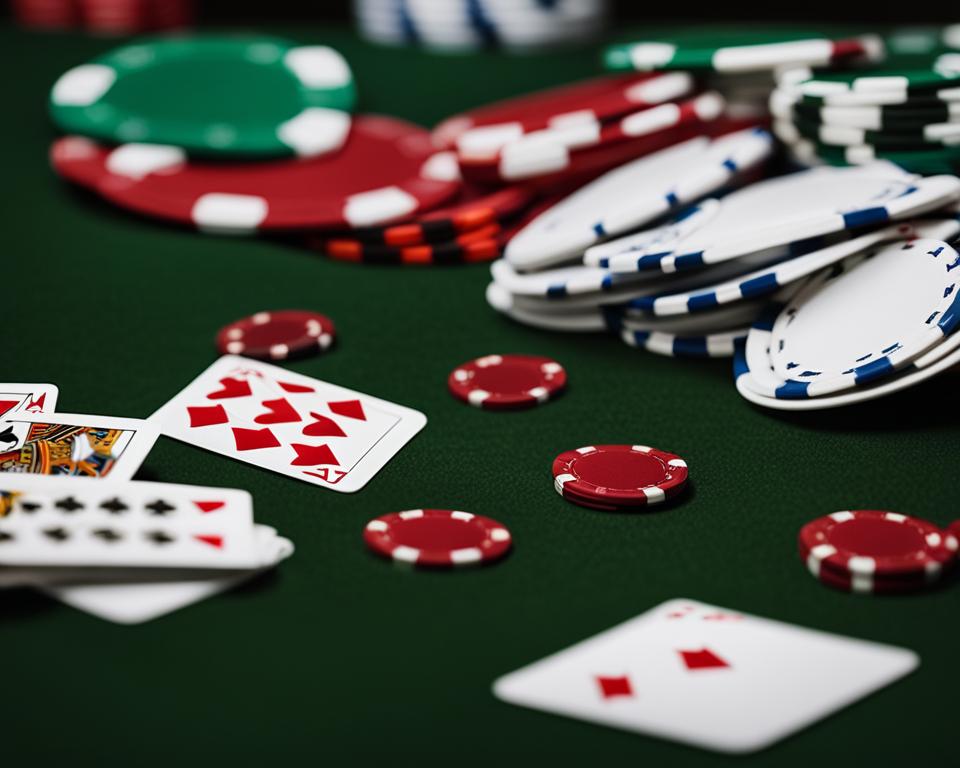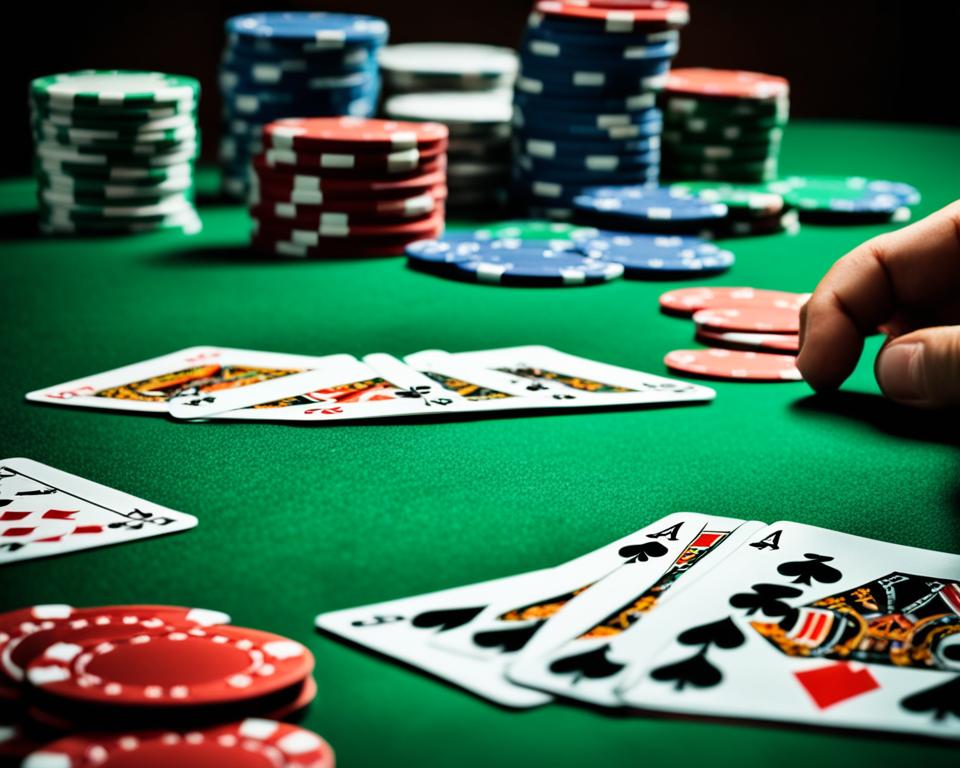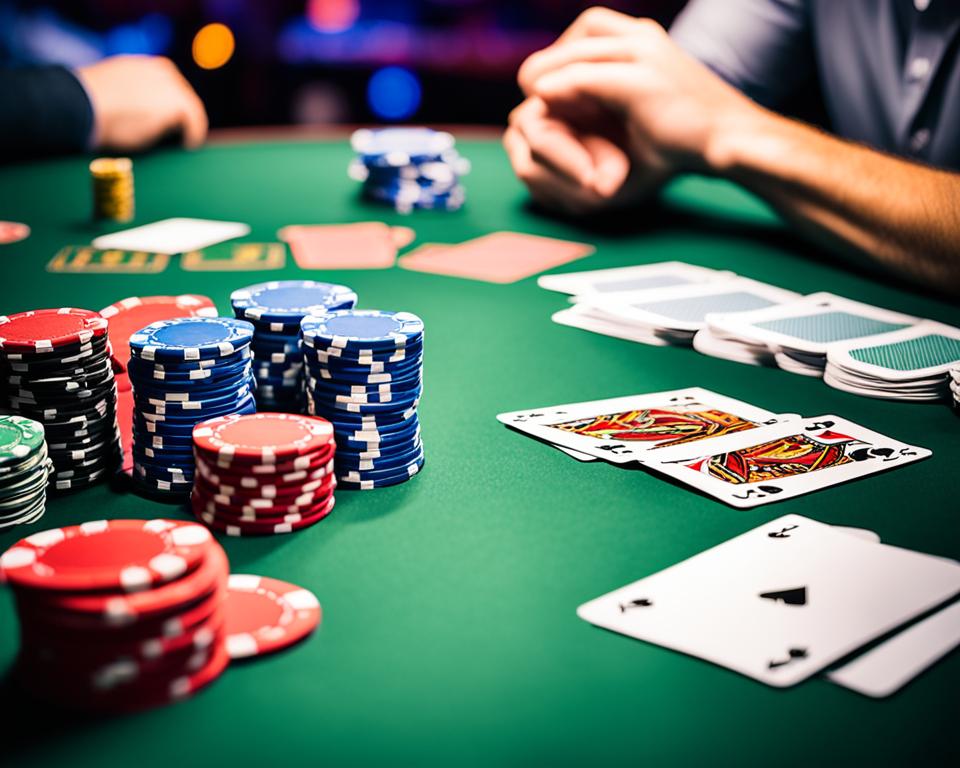This quick guide aims to help beginners understand and navigate the world of poker terminology. Whether you’re playing online or at a physical table, it’s important to be familiar with the terms used by other players. By learning these essential poker terms, you’ll feel more confident and knowledgeable at the poker table.
Key Takeaways:
- Understanding poker terminology is essential for beginners.
- Learning these terms will improve your confidence at the table.
- Familiarize yourself with terms like add-on, all-in, and ante.
- Recognize terms like bad beat, bicycle, and big slick.
- Know the meaning of blinds, bluff, and board.
Add-On, All-In, Ante
For beginners venturing into the exciting world of poker, understanding the essential terminology is key to feeling confident at the table. In this section, we’ll explore three critical terms: add-on, all-in, and ante. These beginner-friendly poker terms will help you grasp the flow of the game and the actions players can take.
Add-On
The add-on is a term used to describe the action of adding chips to your stack after the initial period of play, typically during a designated break in a tournament. It allows players to increase their chip count and continue playing with a larger stack. Utilizing the add-on option can provide players with a strategic advantage and increase their chances of success.
All-In
Going all-in in poker means placing all your chips into the pot, committing yourself to the current hand. When a player declares themselves all-in, they cannot make any further bets beyond the chips they have already contributed. This high-stakes move creates tension and excitement at the table, making it a thrilling moment in any game.
Ante
The ante is a bet made before the cards are dealt on each hand. It ensures that there is money in the pot right from the start, creating an initial incentive for players to participate in the hand. The ante is usually a predetermined amount set by the table or tournament rules, providing a foundation for the subsequent betting rounds.
By familiarizing yourself with these beginner-friendly poker terms—add-on, all-in, and ante—you will gain a deeper understanding of the game’s dynamics and the actions players can take. Now that you have a grasp on these fundamental concepts, let’s delve further into the world of poker terminology in the following sections.
Bad Beat, Bicycle, Big Slick
As a beginner navigating the world of poker, it’s important to familiarize yourself with essential poker terminology. Understanding these terms will not only help you feel more confident at the poker table but also enable you to communicate effectively with other players. In this section, we’ll explore three key terms: bad beat, bicycle, and big slick.
Bad Beat
The term “bad beat” refers to a hand where you lose to a player against the expected odds. It often occurs when you have a strong hand, such as a full house or a flush, but are beaten by a player who makes an unlikely comeback with a better hand. Experiencing a bad beat can be frustrating, but it’s a common occurrence in the game of poker.
Bicycle
A “bicycle” is a nickname for a low straight consisting of the cards A-2-3-4-5. This type of straight is considered the lowest possible straight in poker and holds great significance in certain games, such as lowball variants. Understanding the concept of a bicycle is essential when playing these specific variations of poker.
Big Slick
When you are dealt an Ace and a King as your starting pocket cards, it is commonly referred to as “Big Slick.” This hand is considered strong and holds great potential for making top pair, strong two pairs, or even connecting with the community cards to make a powerful hand. Recognizing the significance of Big Slick is crucial when assessing the strength of your starting hand.
By familiarizing yourself with these important poker terms, you’ll be equipped with the knowledge necessary to understand the outcomes and possibilities during gameplay. Whether you’re facing a bad beat, recognizing a bicycle, or holding Big Slick, these terms are essential for every beginner poker player.
To enhance your understanding of these terms, here is a comprehensive table summarizing their definitions:
| Term | Definition |
|---|---|
| Bad Beat | A hand where you lose to a player against the expected odds. |
| Bicycle | A nickname for a low straight consisting of the cards A-2-3-4-5. |
| Big Slick | The nickname for when you are dealt an Ace and a King as your starting pocket cards. |
Now that you have a solid understanding of these poker terms, you’re well on your way to becoming a more knowledgeable player. In the next section, we’ll explore more common poker lingo to further expand your poker vocabulary.
Blinds, Bluff, Board
As you dive into the world of poker, it’s essential to familiarize yourself with the common poker terms that players use at the table. This section will introduce you to three crucial terms: blinds, bluff, and board.
Blinds
In a poker game, blinds are compulsory bets placed by the two players sitting to the left of the dealer before the cards are dealt. The purpose of blinds is to ensure there is action and money in the pot right from the beginning of each hand. The player sitting immediately to the left of the dealer places a smaller bet known as the “small blind,” while the player to their left places a larger bet called the “big blind.” The blinds rotate clockwise around the table after each hand, ensuring each player takes their turn in these positions.
Understanding blinds is vital because they directly impact the betting structure and influence the strategies players adopt during a hand. Being in the blinds requires careful consideration, as you’ll be forced to put money into the pot without seeing your cards.
Bluff
Bluffing is an essential part of poker strategy and refers to attempting to deceive other players by representing a stronger hand than you actually have. Bluffing involves making aggressive bets or raises with the intention of forcing opponents to fold their hands, even if they have better cards.
A successful bluff requires careful observation of other players’ behavior, reading their potential hand strength, and choosing the right moment to execute your bluff. It’s a skill that develops over time and can greatly enhance your chances of winning, as it allows you to win pots without having the best hand.
“Poker is a game of skill, where the ability to bluff effectively can make all the difference between winning and losing.”
Board
The board refers to the community cards that are placed face-up on the table and can be used by all players to form their hands. In games like Texas Hold’em and Omaha, the board consists of five cards placed in sequential rounds known as the flop, turn, and river.
Understanding the board is crucial for strategic decision-making. It allows you to assess the strength and potential combinations of hands available not only to yourself but to your opponents as well. Reading the board helps you determine the overall strength of your hand in relation to the possible hands your opponents might hold, leading to wiser betting and folding decisions.
Mastering these poker lingo terms will empower you as a beginner player, giving you a better understanding of the game, improving your decision-making, and enhancing your overall poker experience.
Boat, Burn, Button
In the exciting world of poker, there are several important terms that every beginner should be familiar with. In this section, we will explore three essential concepts: boat, burn, and button. Understanding these basic poker terms will help you navigate the game with confidence and clarity.
Boat
A “boat” is a popular nickname for a full house. Imagine having three cards of one rank and two cards of another rank in your hand – that’s a boat! It’s a powerful hand that can lead to big wins and exciting gameplay.
Burn
Before dealing the flop, turn, and river – the community cards that are placed face up on the table – it’s customary to “burn” a card. This means discarding the top card of the deck to ensure fairness and prevent any cheating. So, don’t be surprised when you hear the term “burn” during a game.
Button
Have you ever wondered about that small round disc on the table? That’s the “button.” In poker, the button represents the dealer position and rotates clockwise after each hand. The player with the button acts as the dealer and has certain advantages in terms of betting position. It’s an important position to be aware of during gameplay.
Now that you have a better understanding of these basic poker terms – boat, burn, and button – you’ll be able to confidently participate in poker games and enjoy the excitement of the table. Keep expanding your poker vocabulary and exploring more terms to enhance your gameplay and strategy.
| Term | Definition |
|---|---|
| Boat | A full house, consisting of three cards of one rank and two cards of another rank. |
| Burn | The act of discarding the top card of the deck before dealing the community cards. |
| Button | The dealer position indicated by a round disc that rotates clockwise after each hand. |

Buy-In, Call, Cash In
Understanding the financial aspects of playing poker is essential for beginners. In this section, we’ll explore three important terms that relate to the money involved in the game: buy-in, call, and cash in.
Buy-In
A buy-in refers to the process of exchanging cash for chips in order to sit at a poker table. Whether you’re playing at a casino or in an online poker room, you’ll need to buy your chips before you can start playing. The amount of the buy-in typically determines the minimum and maximum bets at the table. It’s important to note that different tables may have different buy-in requirements, so be sure to check before joining a game.
Call
When a player chooses to match the highest bet made so far, it is known as a call. For example, if the previous player has bet $10, and you want to continue playing, you would need to call the $10 bet by placing an equal amount of chips into the pot. Making a call allows you to stay in the hand and potentially win the pot if you have a winning hand.
Cash In
After you’re done playing, cashing in is the process of leaving the poker table and exchanging your chips for cash. This usually happens at the cashier’s booth or designated area in a physical casino. If you’re playing online, you’ll likely have the option to cash in your chips and transfer the funds back to your account. It’s important to note that each poker room or casino may have specific rules and procedures for cashing in, so be sure to familiarize yourself with them beforehand.
Understanding these terms related to the financial side of poker will help you navigate the game with confidence. Whether it’s buying in, making a call, or cashing in your chips, having a clear understanding of the financial aspects ensures a smooth poker experience.
| Term | Definition |
|---|---|
| Buy-In | The process of exchanging cash for chips to join a poker table. |
| Call | Matching the highest bet made so far to stay in the hand. |
| Cash In | Exchanging chips for cash when leaving the poker table. |
Check, Check-Raise, Community Cards
When playing poker, it is essential to understand some basic terms that will help you navigate the game more confidently. This section explores the concepts of checking, check-raising, and community cards.
Checking: In poker, checking refers to the action of making no bet when no one else has placed a bet either. It is an option to pass the opportunity to bet to the next player without forfeiting your turn. By checking, you can evaluate the current situation and decide on your subsequent move.
Check-Raise: Check-raise is an advanced play in poker where a player initially chooses to check and then raises the bet when another player places a bet. It is a strategic move used to deceive opponents and extract more value from a strong hand. This tactic can be highly effective in creating a larger pot and putting pressure on your opponents.
Community Cards: Community cards are the flop, turn, and river cards dealt face up in the middle of the table. These cards are shared by all players and form part of their final hand. The community cards play a crucial role in determining the outcome of the game and influence the available betting options. They provide both opportunities and challenges for each player to create the best possible hand.
Example:
“John checked his hand and decided to check. Anna then placed a bet, and John seized the opportunity to employ a check-raise strategy, surprising Anna with a substantial raise. The community cards were revealed, adding more excitement to the pot and increasing the intensity of the game.”
Understanding the concepts of checking, check-raising, and community cards is essential for beginners to enhance their strategic decision-making abilities and fully participate in the game. By familiarizing yourself with these terms, you’ll be better equipped to make informed choices and navigate the complex dynamics of poker.

Cowboys, Fifth Street, Final Table
As a beginner, it’s essential to familiarize yourself with the poker vocabulary used by experienced players. Knowing terms like “Cowboys,” “Fifth Street,” and “Final Table” will give you insights into specific stages and situations during the game.
Cowboys: Cowboys is a nickname given to a pocket hand consisting of two Kings. It’s one of the strongest starting hands in poker and can put you in a favorable position at the table.
Fifth Street: In a game of poker, Fifth Street refers to the fifth and final community card dealt face up on the table. This card is also commonly known as the “river.” It plays a crucial role in determining the outcome of the hand and can greatly impact your chances of winning.
Final Table: The final table is the last table in a tournament where all other players have been eliminated. Making it to the final table is a significant accomplishment and often comes with higher stakes and more intense competition. It’s a battleground where champions are crowned and fortunes are won.
By understanding and using these terms, you’ll be able to navigate the game with more confidence and clarity. Now, let’s dive deeper into the world of poker terminology to enhance your understanding.
Other Sections not to Duplicate:
Sections 1, 2, 3, 4, 5, 6, 7, 9, 10.
Fish, Flush, Fold
Understanding the basic poker terms is essential for beginner-friendly gameplay. Let’s dive into three important terms that every novice player should know:
Fish
A fish is a player who stays in pots hoping to catch the right cards against the odds. They often play inexperienced and make poor decisions at the table. Recognizing a fish can be advantageous as you can exploit their weaknesses and maximize your winnings.
Flush
A flush is a powerful hand consisting of five cards of the same suit. The cards can be of any rank, as long as they all belong to the same suit. The flush is ranked higher than a straight but lower than a full house in the hand rankings. It’s important to understand the value of a flush when evaluating the strength of your hand.
Fold
Folding is a strategic move in poker where a player chooses to discard their hand without showing their cards. This decision is made when a player believes their hand is weak or when they want to minimize their potential losses. Folding can save you from making costly mistakes and is an integral part of successful poker play.
By familiarizing yourself with these beginner-friendly poker terms, you’ll be better equipped to understand player behavior and hand rankings, making smarter decisions at the poker table.
| Poker Term | Definition |
|---|---|
| Fish | A player who stays in pots hoping to catch favorable cards against the odds. |
| Flush | A hand consisting of five cards of the same suit. |
| Fold | To discard your hand without showing your cards. |
Conclusion
Mastering the basics of poker terminology is crucial for beginners to feel confident and engage in meaningful gameplay. By understanding poker terms for beginners, you’ll be able to communicate effectively with other players and make informed decisions at the table.
Remember, poker is not just about luck; it’s also about strategy and skill. Familiarizing yourself with beginner-friendly poker terms is the first step towards becoming a successful player.
As you continue to play and practice, don’t be afraid to expand your poker vocabulary. Learning more advanced terms and strategies will enhance your understanding of the game and give you an edge over your opponents. So keep studying, keep playing, and watch your poker skills grow!
FAQ
What is an add-on in poker?
Adding chips to your stack after the initial period of play is known as an add-on.
What does it mean to go all-in in poker?
Going all-in means placing all your chips into the pot.
What is an ante in poker?
An ante is a bet made before the cards are dealt on each hand.
What is a bad beat in poker?
A bad beat refers to a hand where you lose to a player against the expected odds.
What is a bicycle in poker?
A bicycle is a nickname for a low straight, specifically the cards A-2-3-4-5.
What does “Big Slick” mean in poker?
“Big Slick” is the nickname for when you are dealt an Ace and a King.
What are blinds in poker?
Blinds are compulsory bets placed by the two players sitting to the left of the dealer before the cards are dealt.
What is bluffing in poker?
Bluffing is attempting to deceive other players by representing a stronger hand than you actually have.
What does “the board” mean in poker?
The board refers to the community cards that are showing on the table.
What is a boat in poker?
A boat is a nickname for a full house, which is a hand with three cards of one rank and two cards of another rank.
What does it mean to burn a card in poker?
Burning a card means discarding it before dealing the flop, turn, and river.
What is the button in poker?
The button refers to the dealer button that denotes the position of the player in the seat of the dealer.
What is a buy-in in poker?
A buy-in is the exchange of cash for chips in order to sit at a table.
What does it mean to call in poker?
To call means to match the highest bet made so far.
What is cashing in in poker?
Cash in is the act of leaving the table and exchanging your chips for cash.
What does it mean to check in poker?
Checking means making no bet when no one else has placed a bet either.
What is a check-raise in poker?
Check-raise is a play where you initially check and then raise an opponent’s bet.
What are community cards in poker?
Community cards are the flop, turn, and river cards dealt face up in the middle of the table.
What are “Cowboys” in poker?
“Cowboys” is a nickname for when you are dealt two Kings as your pocket cards.
What is Fifth Street in poker?
Fifth Street refers to the fifth and final community card, also known as the river.
What is the final table in poker?
The final table is the last table in a tournament when all other players have been eliminated.
What is a fish in poker?
A fish is a player who stays in pots hoping to catch the right cards against the odds.
What is a flush in poker?
A flush is a hand consisting of five cards of the same suit.
What does it mean to fold in poker?
To fold means to throw away or discard your hand without showing your cards.
Why is it important to learn poker terminology?
Mastering the basics of poker terminology is crucial for beginners to feel confident and engage in meaningful gameplay.





